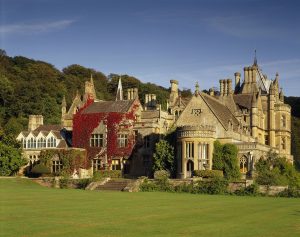
The Gibbs Pedigree dates from the 16th century and the coat of arms and motto (tenax propositi – tenacious of purpose) were assigned to the family of Gibbs as early as 1691. Diligent research in Devonshire archives will, in due time, probably unravel the story and take us back to the 14th century.
There are records of Gibbs of those days being rich, powerful and lawless, considerable figures in this land of merchants and venturers, who lived within the valley of the Dart river and gravitated up the coast to Clyst St. George, across the fields from the little port of Topsham on the Exe in the gentler country that bounds the estuary below the great wool trading cathedral city of Exeter (pictured here in the year 1816).

In the 1800s, a descendant Antony Gibbs, who was educated at Exeter Grammar School, undertook an apprenticeship as a wool merchant in Exeter, learnt Spanish, and was in business on his own at the age of 22.
He married into wealth – Dorothea Barnetta Hucks – although, over-sanguine attitudes were his undoing and the successful business he had built up in Spain and elsewhere crashed in 1789.

He then left Devonshire for Spain to rebuild his life and business there, and soon built up business and partnerships in Cadiz, Malaga and Lisbon.
With the help of his sons, William and Henry, business thrived, and in 1805 Antony chartered a Spanish ship to take British goods stranded in war torn Spain, to Lima, South America – seat of the Spanish Viceroy. Antony planned to found the London house Anthony Gibbs & Son with the profits of this Lima adventure.
Son Henry, meanwhile, was in Tangier and in Cadiz founding the chief limb of the new London house. Business between London and Cadiz put the firm on a solid footing and Gibbs left their Exeter base and took a series of houses in London.
Antony died in 1815, and it is to his sons Henry and William that the rise of Antony Gibbs & Sons was due and they brilliantly steered the fortunes of the firm.

Trading in South America continued and as the Gibbs began to make fortunes, so they began to build and restore churches, to found schools and colleges and hospitals.
William died in 1875 and left the ownership of the house of Antony Gibbs & Sons to Henry Hucks, his nephew and partner. Henry Hucks was a Member of Parliament for the City of London from 1891-1892, and with four able sons in the partnership, he led the firm to new heights and successes.
The mainstay of the business was still the guano trade with South America and ‘Mr Gibbs made his dibs, selling the turds of foreign birds’, was the city’s jingle.
The firm was also active in the manufacture and export of nitrate of soda and Chilean iodine, as agents for the Chilean State Railways and in the banking and issuing business. Later the firm began to explore the business of mining, insurance and timber.

Nitrates were the main source of explosives for the Allies in the first world war, however after the war, there was a big fall in demand for fertilisers, and the firm never really recovered from the grave blow of the nitrate disaster.
One of the best know ships owned by Antony Gibbs & Sons from 1882 to 1886, was the SS Great Britain, now in Bristol Harbour. From 1852 until 1881 the ship was owned by Gibbs, Bright and Co. and used extensively on the Australia run.
The firm continued to flourish, becoming a company in 1948 and going public with great success in 1972.

In 1980, the family finally sold out to the Hong Kong and Shanghai Bank.
The history of the Gibbs Family lives on today at Tyntesfield (near Wraxall, north Somerset) home to Antony’s son William in 1843 and a fine example of a Victorian Gothic revival country house. The house passed on through the family until, in 2002, it was bought by The National Trust. The house is now open to the public and continues to thrive as a living testament to the Gibbs Family. Useful links: Wikipedia Entry
